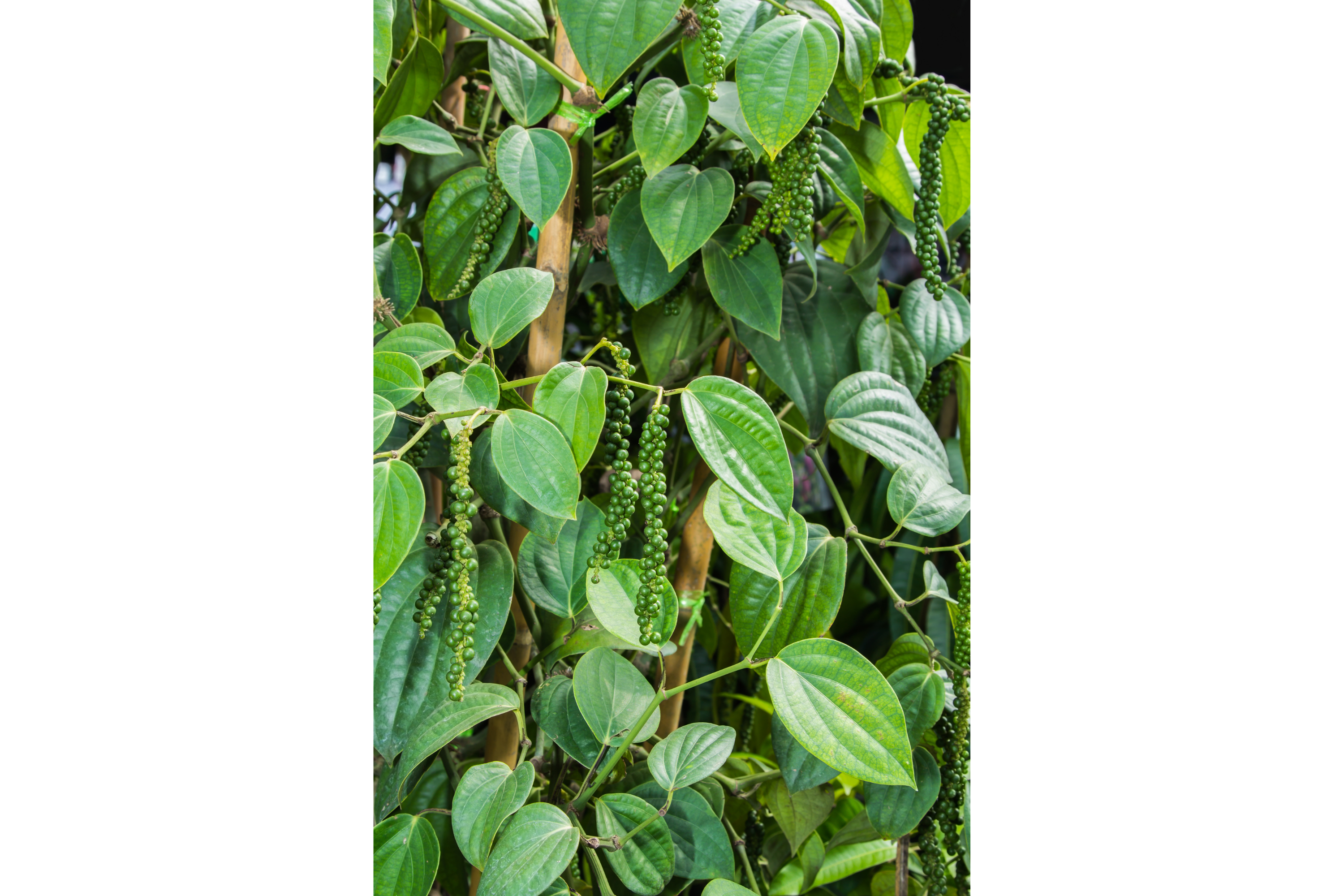Black pepper
(Piper nigrum)

Description
Piper nigrum, commonly known as black pepper, is a flowering vine in the family Piperaceae, native to the Malabar Coast of India. It is widely cultivated for its fruit, which is dried and used as a spice and seasoning. Taxonomy and Botanical Description Piper nigrum is a member of the family Piperaceae, which includes approximately 3,600 species of tropical and subtropical plants. The genus Piper contains approximately 2,000 species, including Piper nigrum, Piper betle (betel leaf), and Piper methysticum (kava). The black pepper plant is a perennial vine that can grow up to 10 meters in length. It has small, inconspicuous flowers that are borne on spikes, and its fruit is a small, spherical drupe that contains a single seed. The fruit of the black pepper plant is green when it is unripe, turning to red as it ripens. The seeds are harvested when the fruit is fully ripe, then dried and processed to produce black pepper. Habitat and Distribution Piper nigrum is native to the Malabar Coast of India, but it is now widely cultivated in tropical regions around the world. It is grown commercially in countries such as Indonesia, Malaysia, Brazil, Vietnam, and India, as well as in other parts of Southeast Asia and South America. In terms of habitat, Piper nigrum is typically found in warm, humid environments. It thrives in rich, well-drained soil that is high in organic matter, and it requires a lot of moisture. The plant is often grown in shade or partial shade, as direct sunlight can be harmful to its leaves. In the wild, Piper nigrum is found growing in forests and other natural habitats in its native range. However, due to its popularity as a spice and seasoning, it is now widely cultivated and can be found growing in a variety of agricultural settings, including plantations and small-scale farms. Cultivation and Production Black pepper is cultivated in many tropical regions of the world, including India, Indonesia, Malaysia, Brazil, and Vietnam. The plant is typically grown as a trailing vine on trellises or other support structures. The soil in which it is grown must be rich in organic matter and well-drained, with a pH between 5.5 and 6.5. The plant requires a warm, humid climate with temperatures ranging between 20 and 30 degrees Celsius. The harvesting of black pepper is done manually, and it is a labor-intensive process. The harvested fruit is washed, boiled, and then dried in the sun or with hot air. The outer layer of the fruit, which is rich in essential oils, is removed during this process, leaving the inner seed, which is the black pepper that is commonly used as a spice. Uses Piper nigrum, or black pepper, is primarily used as a spice and seasoning in culinary applications. Its pungent, slightly sweet flavor and distinctive aroma make it a popular ingredient in a wide range of dishes, including soups, stews, marinades, and rubs. Black pepper is often used in combination with other spices, such as cinnamon, cloves, and nutmeg, to create complex flavor profiles. In addition to its culinary uses, Piper nigrum has a long history of use in traditional medicine. It has been used to treat a variety of ailments, including digestive problems, respiratory issues, and skin irritations. Recent studies have also shown that black pepper may have anti-inflammatory and antioxidant properties, making it a potentially valuable ingredient in functional foods and supplements. Other uses of Piper nigrum include: Fragrance: The essential oil of Piper nigrum is used in perfumes, soaps, and other personal care products. Insecticide: The fruit of Piper nigrum contains a compound called piperine, which has insecticidal properties and has been used to control pests in agriculture. Preservative: Piper nigrum has natural antimicrobial properties and has been used to preserve food and other perishable items. Traditional rituals: In some cultures, black pepper is used in traditional rituals and ceremonies. Overall, Piper nigrum is a versatile plant with a wide range of uses, from culinary to medicinal to industrial. Its popularity and versatility have made it an important crop in many parts of the world. Conservation Status Piper nigrum, or black pepper, is not considered a threatened species and is not listed on the International Union for Conservation of Nature (IUCN) Red List. This is likely due to its widespread cultivation and the fact that it is not primarily grown in natural habitats, but rather in agricultural settings. However, like many other crops, the cultivation of Piper nigrum can have environmental impacts, including deforestation, soil erosion, and the use of pesticides and fertilizers. Additionally, there may be concerns about the genetic diversity of cultivated varieties of Piper nigrum, as many commercial strains are propagated asexually, which can lead to a loss of genetic variability. To address these issues, efforts are being made to promote sustainable cultivation practices and to preserve the genetic diversity of Piper nigrum. This includes the development of new varieties that are resistant to pests and diseases, as well as efforts to conserve and study the genetic diversity of wild populations of Piper nigrum. Conclusion: Piper nigrum, or black pepper, is a widely cultivated and popular spice that is used in cuisines around the world. Its distinctive flavor and aroma have made it a favorite among chefs and home cooks alike, and its potential health benefits have made it a valuable ingredient in traditional medicine. Whether used to season a savory dish or to add flavor to a sweet treat, black pepper is a versatile and essential ingredient in any kitchen.
Taxonomic tree:







